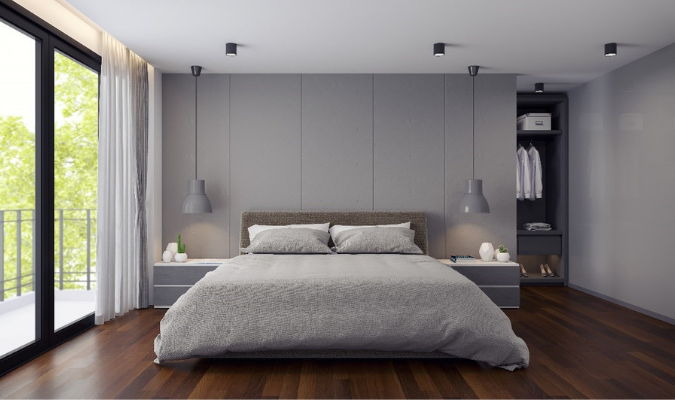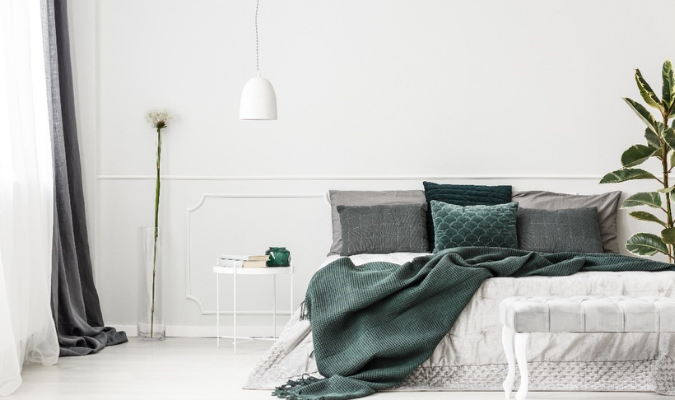It takes more than just a super soft duvet and a plush carpet to make your bedroom feel like a sanctuary. It’s about having the right colour combinations, too.
One quick way to do this is by coordinating your curtains and bedding. Often the first and last thing you see before turning in for the night, choosing colours which work in harmony could mean the difference between a good or bad night’s sleep. No, really.
Read on to see how to style your bedroom like an interior designer.
Choose your colours carefully
Coordinating the colour wheel involves much more than sourcing identical swatches. To successfully coordinate colours there is the task of finding complementary tones, too.
Below are just some of the ways you can do this with your curtains and bedding fabrics.
Matching tones
If it’s your first-time coordinating fabrics, play it safe with a matching colour palette. If you have neutral bedding, for instance, you can’t go wrong with a pair of tan curtains. Beige, cream and white tones suit muted bedding just as well.
Look to your bedroom wall colours for inspiration. For instance, if your walls are white, a soft silver pair of curtains or a light-toned bedspread will work perfectly. If, on the other hand, you’re looking to complement dark and moody wall colours, try slate grey curtains or vermillion throws.
TOP TIP: Be careful not to be too “matchy-matchy”. A matching combination of bedspreads, curtains, and walls could appear dull and uninspiring, so try to opt for a maximum of two identical colours throughout your bedroom.

Contrasting palette
Did you know ‘complementary’ also means ‘contrasting’ in the design world? While it might seem counterintuitive, colours are considered complementary when they combine to make black or white. For example, red and green (two opposites in the colour wheel) are considered complementary to each other.
To bring complementary colours into your bedroom, start with your bedding. If you have white bed sheets, you can create a monochromatic look with deep charcoal curtains or blackout blinds. Alternatively, you can introduce bold colours schemes into your décor by mixing up your favourite complementary colours e.g. blue bedding with burnt orange curtains.
TOP TIP: If you’re unsure which complementary colours to use, opt for a toned-down version of your favourite pairing.
Play with patterns
Interior design doesn’t stop at block colours; there are lots you can do with patterns and prints, too. Floral patterns with a dusky yellow undertone, for instance, usually pair well with sunshine yellows and pastel shades. Our Kenzie range in Buttercup works beautifully with creams and light hues.
TOP TIP: While coordinating patterns helps to highlight your bedroom’s statement pieces, you should be mindful of going overboard. Too many patterns in one space could be overwhelming.
Match textures

Once you’ve decided which colours you’ll be using in your bedroom, the next step is to coordinate textures.
It may sound simple enough, but there are a lot of different styles to choose from. Whether you’re using velvet, silk, cotton or a different texture, choosing the right material is an effective way to bring ‘visual weight’ to your space.
Let’s put this into perspective. Imagine your bedding is clad in soft pink cotton (a material with a smooth, weighted look). You wouldn’t want to coordinate it with a set of vermillion velvet curtains, as this is a rough and heavily weighted textile. Instead, a cotton or polyester curtain set would offer a complementary aesthetic. If, on the other hand, your bedding is more chintzy and decorative, your space might benefit from soft, flowing sheer curtains.
TOP TIP: If you’re in doubt about how to coordinate your curtains with your bedding, it’s always a good idea to buy the fabrics from the same place. This way, you can be sure that you can match patterns or colour families.
For your pick of the best fabrics for curtains and bedding, take a look at the Plumbs range.
